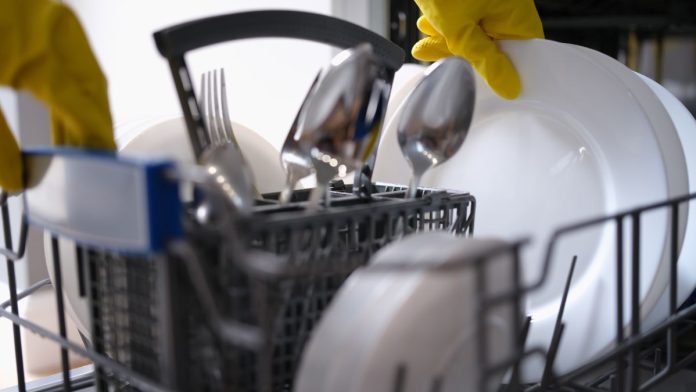Contemporary Cleaning Solutions: The Evolution of Dishwasher Detergent Formulations
On the household appliance front, biodegradable dishwasher detergent is convenient and efficient. Their work relies on a detergent that has evolved. This evolution is driven by technical advances, environmental concerns, and changing consumer needs.
Once, phosphate-based dishwasher detergents were simple. Phosphates softened water and broke down food particles, reducing dish stains and film. The environmental effects of these substances, especially water pollution and eutrophication, pushed detergent formulation changes.
In the late 20th century, many countries banned phosphates, which was a turning point. Manufacturers had to find non-toxic chemicals that could clean, like phosphates.
Enzymes like proteases and amylases have revolutionized dishwasher detergents. Proteases break down protein stains, while amylases break down starches. Enzymes have made detergents greener and more efficient at lower temperatures, saving energy.
Effective and environmentally friendly surfactants are another significant advancement. These compounds lower water surface tension, making it easier to clean filthy dishes. The change to less harmful surfactants for aquatic life is due to environmental awareness and regulatory demands.
Health and safety have been prioritized alongside environmental concerns. This has reduced or eliminated chlorine and synthetic perfumes, which can cause irritation and other health issues. The shift toward natural and plant-based products is not merely a marketing fad; consumers are concerned about chemical exposure.
The physical form of dishwasher detergents has changed. Powders were initially used, but variable dosing caused varying cleaning results. Tablets and pods solve this problem by delivering pre-measured doses for optimal cleaning and convenience. These forms also combine rinse aids and water softeners, formerly applied separately.
Detergents that remove tea, coffee, and grease residues have also improved, thanks to formulation chemistry. This is especially crucial since diets have changed, and dishwashers are used to clean filthy pots and pans.
The future of dishwasher detergent formulation depends on enzyme and surfactant chemistry advances. More concentrated formulations that use less water and packaging are also being developed to reduce environmental effects.
Home gadgets with innovative technologies may also affect detergent formulations. As dishwashers get more competent and can detect soiling and adapt cycles, detergents must cooperate with them for maximum efficiency and resource-saving.
Finally, the evolution of dishwasher detergent compositions shows how technological innovation, environmental responsibility, and customer needs interact. Manufacturers must continue to balance these frequently conflicting objectives, pushing chemistry and technology to create effective, safe, and sustainable products. Dishwasher detergents have evolved from simple phosphate-based formulae to complex, multi-component ones, demonstrating our creativity and capacity to adapt to changing circumstances and expectations.
Modern Dishwasher Detergents: Transforming Kitchen Cleanliness
With the emergence of new dishwasher detergents, kitchen cleanliness has changed drastically. Dishwashing detergents are designed to combat everything from persistent stains to environmental problems. They clean well and show these domestic staples’ complex chemistry and science.
Cleaning dishes requires effective detergents. Modern dishwashing detergents use essential compounds to solve this problem. These compositions need enzymes. Dishes are clean because biological catalysts break down proteins, lipids, and carbohydrates. Modern detergents use proteases and amylases to remove protein and carbohydrate stains.
Surfactants, another essential ingredient, have been improved. These compounds lower water’s surface tension, helping it spread and penetrate dirt. Modern surfactants are eco-friendly and effective in cleaning dishes. This dual role is crucial given consumer knowledge of environmental issues and the need for products without toxic utensil residues.
Water hardness affects dishwashing because minerals can hinder cleaning and leave stains or films. Modern detergents contain water softeners, which bond to these minerals and improve cleaning. This ensures that dishes are clean and attractive, free of hard water marks and streaks.
Some detergents have rinse aids to boost their efficacy. They properly distribute and drain water off dish surfaces, preventing water stains on glassware. Modern detergents address cleaning and attractiveness, which is why rinse aids are used.
Modern dishwasher detergents are versatile. These detergents work in a variety of water temperatures and soiling levels. Adaptability is essential in houses where dishwashing needs vary substantially from cycle to cycle. This also means these detergents work well in all dishwashing models, from older, less efficient ones to the latest high-efficiency ones.
Environmental concerns have greatly influenced dishwasher detergents. This transition is exemplified by removing phosphates, a critical element now proven to pollute water. Eco-friendly, biodegradable substances with less influence on aquatic life have replaced them. This transformation is due to governmental restrictions and consumer demand for sustainable products.
Besides being eco-friendly, current dishwasher detergents offer an enhanced design. Powders to liquids, then tablets and pods, show the continual pursuit of ease, efficiency, and precision in dosing. Tablets and pods are popular because they are easy to use and eliminate the guesswork in establishing detergent amounts, saving waste, and assuring consistent cleaning outcomes.
Modern dishwashing detergents have obstacles. Cleaning power, environmental friendliness, and user safety are difficult to balance. Newer dishwashers have more sensors and cycles, so detergents must keep up to stay compatible and effective.









